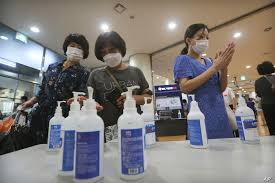The World Health Organisation (WHO) on Thursday (July 9) published an updated version of its March 29 scientific brief, ‘Modes of transmission of virus causing COVID-19: implications for infection prevention and control (IPC) precaution recommendations’, which it said included “new scientific evidence available on transmission of SARS-CoV-2, the virus that causes Covid-19”.
In the brief, the WHO has formally acknowledged the possibility that the novel coronavirus can remain in the air in crowded indoor spaces, where “short-range aerosol transmission… cannot be ruled out”.
The updated brief has come three days after a group of 239 scientists from 32 countries published a commentary titled ‘It is Time to Address Airborne Transmission of COVID-19’, in which they issued an “appeal to the medical community and to the relevant national and international bodies to recognize the potential for airborne spread of COVID-19”.
Earlier, on Tuesday (July 7), a day after the scientists’ open letter was published, Maria van Kerkhove, the WHO’s technical lead on the pandemic, had told the daily Covid-19 news briefing that “we have been talking about the possibility of airborne transmission and aerosol transmission as one of the modes of transmission” of the virus.
So, what has the WHO said in its updated brief?
Referring to several recent studies, the WHO has said that some outbreaks that have occurred in crowded indoor spaces suggest “the possibility of aerosol transmission”, although “combined with droplet transmission”. Such situations have arisen “during choir practice, in restaurants or in fitness classes”.
According to the WHO, “in these events, short-range aerosol transmission, particularly in specific indoor locations, such as crowded and inadequately ventilated spaces over a prolonged period of time with infected persons cannot be ruled out”.
There is, however, a caveat — the WHO does not think that even in these situations, the virus was transmitted exclusively by the aerial route.
The WHO brief still says that “the detailed investigations of these clusters suggest that droplet and fomite transmission could also explain human-to-human transmission within these clusters”.
Transmission through respiratory droplets — when an infected person coughs, sneezes, talks, or sings — is still understood to be the primary mode of transmission of the virus.
Fomite transmission on the other hand, refers to transmission through infected surfaces — such as doorknobs, elevator buttons, handrails, phones, switches, pens, keyboards and, if not disinfected, even a doctor’s stethoscope.
But what is important is that the WHO has previously maintained that airborne transmission of the virus is not a concern outside of situations in which healthcare workers are engaged in certain medical procedures that generate aerosols.
And while it still continues to stress that “current evidence suggests that transmission of SARS-CoV-2 occurs primarily between people through direct, indirect, or close contact with infected people through infected secretions such as saliva and respiratory secretions, or through their respiratory droplets”, the new brief acknowledges that aerosol transmission can occur “outside of medical facilities” as well.
The new brief does not, however, address the question of the relative contributions of transmission by droplets, fomites, and aerosols to the spread of Covid-19. There isn’t enough evidence yet, it suggests.
It says: “Urgent high-quality research is needed to elucidate the relative importance of different transmission routes; the role of airborne transmission in the absence of aerosol generating procedures; the dose of virus required for transmission to occur; the settings and risk factors for superspreading events; and the extent of asymptomatic and pre-symptomatic transmission.”
But is the fact that aerosol transmission can actually happen — as was underlined by the 239 scientists who wrote the open letter, and what the WHO has now acknowledged — a new revelation?
There has been some evidence for aerosol transmission in research already.
* One of the first studies, published in Nature, was conducted in Renmin Hospital and Wuchang Fangcang Field Hospital in Wuhan. It investigated the aerodynamic nature of the virus SARS-CoV-2 by measuring its viral RNA in aerosols.
This study found that the concentration of the virus in aerosols detected in isolation wards and ventilated patient rooms was “very low”, but it was “higher in the toilet areas used by the patients”.
“Levels of airborne SARS-CoV-2 RNA in the most public areas was undetectable, except in two areas that were prone to crowding,” the study stated. “Although we have not established the infectivity of the virus detected in these hospital areas, we propose that SARS-CoV-2 may have the potential to be transmitted through aerosols.”
* In April, a correspondence published on NEJM by researchers from the US National Institute of Allergy and Infectious Diseases in the United States evaluated the stability of SARS-CoV-2 (and SARS-CoV-1, which causes SARS) in aerosols and on various surfaces.
It found that SARS-CoV-2 “remained viable in aerosols” throughout the duration of the experiment that lasted for three hours. “Our results indicate that aerosol and fomite transmission of SARS-CoV-2 is plausible since the virus can remain viable and infectious in aerosols for hours,” the study said.
WHO had then disagreed with these findings. “…The finding of COVID-19 virus in aerosol particles up to 3 hours does not reflect a clinical setting in which aerosol-generating procedures are performed—that is, this was an experimentally induced aerosol-generating procedure,” it had said.
* In May, the US Centers for Disease Control and Prevention (CDC), published a study titled “High SARS-CoV-2 Attack Rate Following Exposure at a Choir Practice”. The researchers, who studied “superspreading events”, found that following 2.5-hour choir practice attended by 61 persons, including a symptomatic index patient, 32 confirmed and 20 probable secondary Covid-19 cases occurred; three patients were hospitalised, and two died.
The study noted that “the act of singing” itself — might have contributed to “transmission through the emission of aerosols, which is affected by the loudness of vocalization”. “Certain persons, known as superemitters, who release more aerosol particles during speech than do their peers, might have contributed to this and previously reported COVID-19 superspreading events,” it said.
“… Aerosol emission during speech has been correlated with loudness of vocalization, and certain persons, who release an order of magnitude more particles than their peers, have been referred to as superemitters and have been hypothesized to contribute to superspeading events. Members had an intense and prolonged exposure, singing while sitting 6–10 inches from one another, possibly emitting aerosols,” it said.
How does life change for you and me now? What does the fact that airborne transmission is possible, mean?
It basically means that wearing a mask becomes even more important than earlier.
It might be possible that N-95 masks, which are used by clinicians in hospital settings, could now be recommended to prevent aerosol transmission, subject to availability, and depending on the health condition of a person.
In its section on ‘How to prevent transmission’, the WHO brief said that apart from hand washing and physical distancing, one should “avoid crowded places, close-contact settings and confined and enclosed spaces with poor ventilation”, and “wear fabric masks when in closed, overcrowded spaces to protect others; and ensure good environmental ventilation in all closed settings and appropriate environmental cleaning and disinfection”.



































